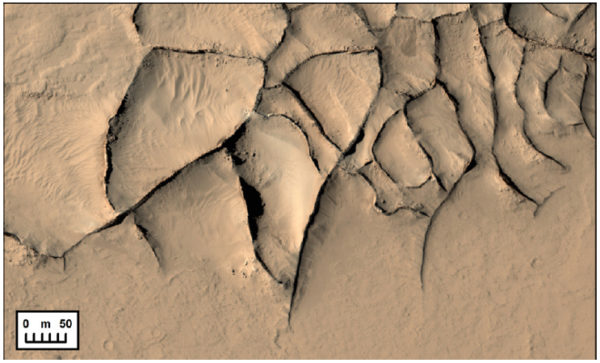Research conducted during the past two decades, which some might describe as the “golden age” of Mars-directed planetary exploration, has taught us a tremendous amount concerning the formation and evolution of the red planet. At the same time, however, scientists’ observations have raised many new questions, and as we continue to explore we learn more every day about exciting new areas such as Mars’ ice ages and climate variations, the role of water, the timing of volcanism, the rate of impact cratering, and many other processes.
Recently, in a study that connects observations ranging in time from the Viking missions in the 1970’s right up to the present, I worked with colleagues from JPL (Laura Kerber, PO ’06) and Brown University (including my former Ph.D. advisor Jim Head) to investigate the formation of unusual polygonal ridge networks on Mars (Figure 1). How do these ridge networks form and what insights, especially into groundwater circulation on Mars, might they therefore provide?
As is often true, the answer is complex: several different mechanisms seem to operate, though all share in common an origin linked to fractures that were later infilled by materials more erosion-resistant than their surroundings. Based on their geologic setting, their spatial correlation (or not) with other chemical and/or hydrological signatures, and their weathering behavior, many polygonal networks appear to have originated as fractures infilled by hydrous mineral deposits, while other networks are more likely fracture systems infilled by magma and/or lava in the near-surface environment. Still other networks may have been infilled by sediments that were later preferentially cemented, rendering them more resistant to regional erosion, but the origin of this feature class remains somewhat enigmatic based on observations available to date.
A great deal remains to be learned, and our initial study makes it clear that as more high resolution data become available new polygonal ridge network examples will continue to be identified, expanding our understanding of these intriguing geologic features. Indeed, as of early 2017 citizen-science volunteers are encouraged to get involved in the search for new examples, with results potentially being used to direct future observations by the HiRISE camera and similar instruments currently in orbit around Mars (see below)!

Figure 1: A HiRISE color close-up of a polygonal ridge network in Gordii Dorsum, Mars (ESP_045409_1915).
For more information:
- Kerber, L., J.L. Dickson, J.W. Head, and E.B. Grosfils, Polygonal ridge networks on Mars: Diversity of morphologies and the special case of the Eastern Medusae Fossae Formation, Icarus, 281, 200-219, 2017.
- JPL News article describing current polygonal ridge network results.
- Join in the citizen-science effort to locate new examples of the polygonal ridge network phenomenon.